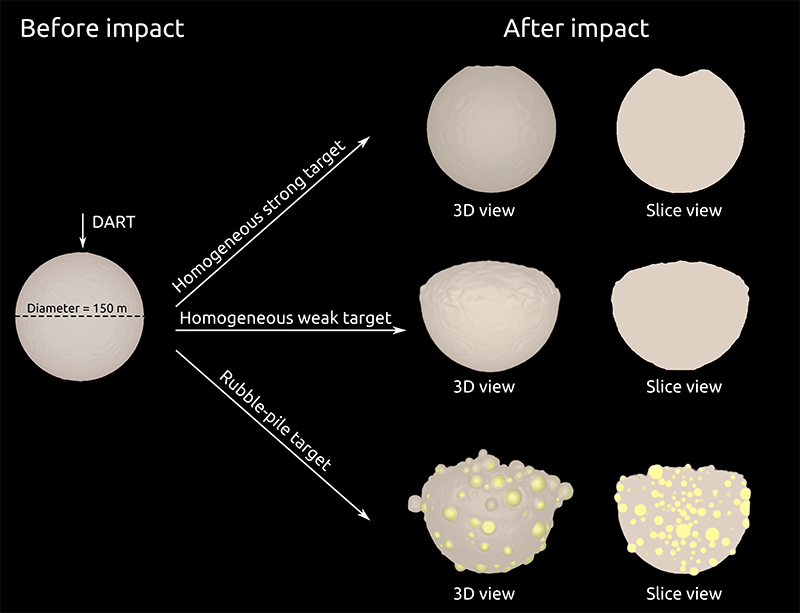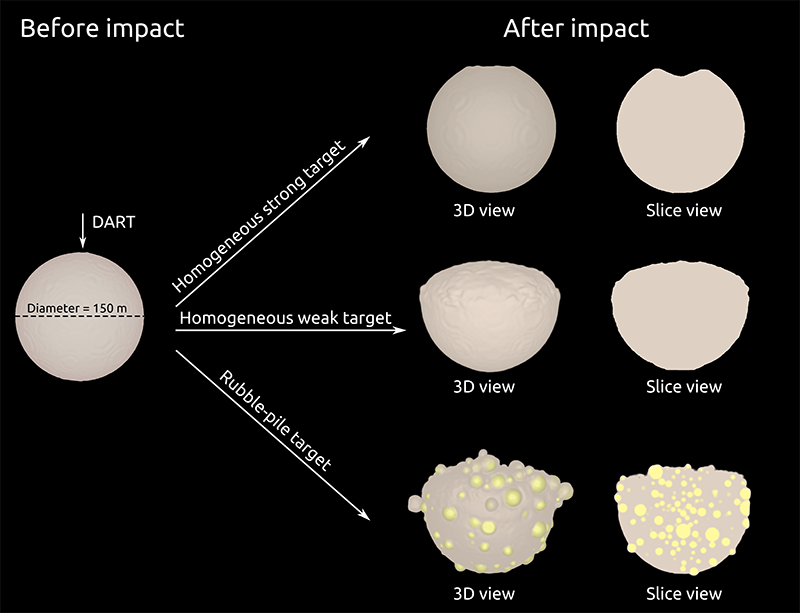If you’re going to do something big, say smash a spacecraft into an asteroid, it seems like a very good idea to have a few practise runs first. But how do you practise something that big without doing it in real life? It’s easy, according to Sabina Raducan, you use a computer.
Following a lifelong interest in astronomy, Sabina works at the University of Bern, Switzerland. She uses a pair of computer codes that can each simulate the effects of an impact on the surface of an asteroid.
“I can take those simulations and make nice movies with them and analyze the data. So, we can actually see what happens without doing the real thing,” she says.
The codes themselves have been developed specifically to model the way rocks fragment due to collisions. As they both work in different ways, she can compare the results to check whether they are consistent. If they are, she can have confidence that this is indeed what would happen in real life. And this is where it all does get real because Sabina is part of the scientific teams for the DART and Hera missions.
DART stands for Double Asteroid Redirection Test. It is a NASA mission that is scheduled to smash into the small asteroid Dimorphos in October 2022. The aim of this collision is to minutely change the trajectory of Dimorphos as a test in case we need to deflect an asteroid away from Earth in the future.
The impact crater that the spacecraft makes will tell us a lot about the nature of the asteroid itself. “Asteroids can be very different from one another. You can have a solid block in space but most of the asteroids, especially those that are closer to us, are actually asteroids that were solid blocks that have been destroyed and then re-accumulated. So they are basically smaller chunks of rock that come together and they are held together only by gravity,” says Sabina.

Figure showing possible asteroid morphologies, after a DART-like impact, from SPH simulations of initially spherical, 150 m in diameter asteroids. There are three target scenarios: a “strong” (50 Pa) target (***50 Pa is still quite weak, but compared to 0 Pa is stronger***), in which case the DART impact produces a crater. A weak target, in which case the DART impact does not produce a crater, but instead causes the global deformation of the asteroid. And a rubble-pile case, in which case there is no crater, and boulders are ejected or redistributed on the asteroid.
The totally solid asteroids are known as monolithic asteroids, while the accumulations of rock are termed rubble piles. The way an asteroid responds to being hit is affected by these properties. Hitting a rubble pile will produce an outcome that is very different from hitting a monolithic asteroid.
So the shape and size of the resulting impact crater is directly relevant to planetary defence because it is in the process of the crater’s creation that the spacecraft’s energy is transmitted to the asteroid, altering its course. If we plan for one type of asteroid but it’s the other, our future deflection attempt might fail.
“Impact cratering is a very complex mechanism. There is a lot of physics that goes on; you will have very high pressures, very high temperatures, and what the asteroid is made of influences what the effects of this impact can be,” says Sabina.
This is why the computer simulations are so important so that the different range of outcomes can be investigated beforehand.
This is also where the Hera mission comes in.
Supplied by ESA, the Hera spacecraft will arrive at Dimorphos in 2026. It will take images of the actual crater, which can then be compared to the simulations. Hera will also perform a thorough analysis of Dimorphos to understand its composition and physical nature.
And if previous asteroid impacts are anything to go by, there will be surprises.

BEFORE AND AFTER Pictures from the Hayabusa2 spacecraft show the surface of the asteroid Ryugu on March 22 (left) and April 25 (right) Japanese time, before and after the spacecraft blasted a crater (dotted line) into the asteroid’s surface. Credit: JAXA, THE UNIV. OF TOKYO, KOCHI UNIV., RIKKYO UNIV., NAGOYA UNIV., CHIBA INSTITUTE OF TECHNOLOGY, MEIJI UNIV., THE UNIV. OF AIZU, AIST
In 2019, Japanese spacecraft Hayabusa2 collected a sample of subsurface rocks from the asteroid Ryugu. To get to those rocks it fired the Small-Carry-on Impactor (SCI) into the surface, making a crater. What happened was a surprise.
“The SCI impact on Ryugu created a crater that was much, much larger than was expected,” says Sabina.
Analysing the results, astronomers now believe this was because the surface of Ryugu is not consolidated, but is more like sand. “We learned so much about asteroids from doing this one experiment. And now we’re going to have the DART impact, which is another large-scale experiment in space. We’ll learn even more, and we’ll expand our knowledge with what happens when you impact something in space, rather than in a laboratory.”
Sabina’s journey to the very forefront of planetary defence started young, when she was attending a summer camp. There were plenty of activities on offer including rowing, archery, fencing – even discussing science fiction. But the one that really struck a chord was astronomy.
“We got the telescope and I just spent the entire night playing with the telescope. And then I was like, yeah, this is what I want to do,” she recalls.
From there she chose physics and astrophysics at university, and at each turning point as her education transformed into her career, the path was clear.
“I guess one thing leads to another. You do an undergrad project, then you do a masters, then a PhD, and you just continue with that,” she says. And that persistence pays off because now she is an integral part of the NEO-MAPP project, working on DART and Hera.
What advice does she have for anyone starting out and wanting to go into astronomy as a career? It’s quite simple: “If you’re school level – primary school or high school – then just focus a bit more on those subjects that could be important like math, computing, physics, a bit of chemistry, and maybe even biology if you want to look for life on other planets.”
And before you know it, you too could be smashing spacecraft into asteroids – either inside a computer or even in real life.
Read Sabina’s scientific papers on Google Scholar.

